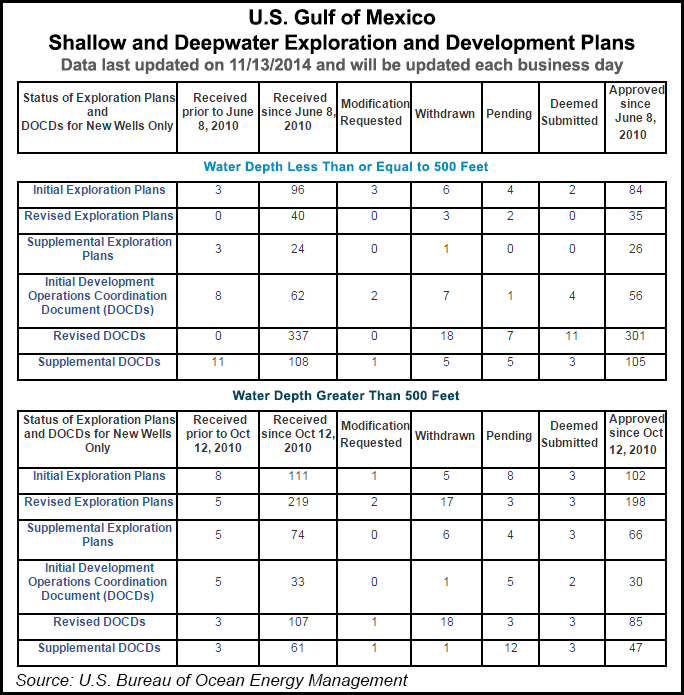NGI Archives | NGI All News Access
Marked Production Growth Ahead for Deepwater GOM, Says Wood Mackenzie
Production in the deepwater Gulf of Mexico (GOM) should hit a new peak of 1.9 million boe/d in 2016, driven by new developments and older field expansions, which would be the first time production would surpass the previous record in 2009, Wood Mackenzie is forecasting.

“2014 is the start of the next significant growth period in deepwater GOM,” said analyst Imran Khan on Thursday.”We expect production from 2014 to 2016 to grow 18% annually. Production from the deepwater is expected to jump in 2015 by 21% year/year, intensifying in 2016,”when the Heidelberg field, operated by Anadarko Petroleum Corp., comes online and the Chevron Corp.-operated Jack/St. Malo in the Lower Tertiary Trend ramps up. By themselves, those three fields would be able to produce 115,000 boe/d in 2016.
Other new fields coming onstream, as well as redevelopments and field extensions would contribute to a surge in output also. Among some of the biggest set to start up over the months are the Chevron-operated Tubular Bells and Big Foot fields (see Daily GPI, Jan. 31); Anadarko-operated Lucius, (see Daily GPI, June 30); and BP plc’s two new producing wells at Thunder Horse (see Daily GPI, Feb. 4).
Once production peaks in 2016, it should plateau through the rest of the decade as legacy fields are depleted and a limited number of new developments come onstream. Only eight developments are scheduled to start up between 2017 through 2020, compared to 15 developments between 2014 and 2016, Wood Mackenzie noted.
Although fewer fields are set to begin operations in the latter part of the decade, the ones that do ramp up would be “important fields that are going to define the long-term success of the region,” said Khan. The Lower Tertiary Trend holds several promising start-ups besides Jack/St. Malo.
“Stones, Shenandoah and North Platte are part of the Lower Tertiary, which has garnered attention because of the potential to find large discoveries,” Khan said. “However, the economics are currently challenging because of high costs, technological limitations and low recovery rates. Unless these obstacles are overcome, it will be difficult for the region to grow in the next decade.” Excluding new discoveries, GOM production from the deepwater could begin to drop in 2021 after plateauing at 1.9 million boe/d.
“The current slide in oil prices does not help the long-term outlook either, especially if the downward trend continues for a prolonged period,” the analyst noted. Wood Mackenzie’s research “emphasizes the need for a sustained level of investment to support production gains. Recent discoveries in deeper waters and in emerging plays require complex drilling and more advanced technologies that are highly capital intensive.”
A typical development well in the Lower Tertiary can cost $300 million, as compared to the shallower, more established well-known plays, such as the Upper/Middle Miocene, where development well costs are closer to $100 million,” Khan said. Consequently, capital expenditures (capex) by offshore operators should be higher in the coming years, particularly in the most promising new plays.
“In order to meet our 2015 production forecast, $17 billion in capex will be required, which is 30% higher than 2013,” said Khan. “The Lower Tertiary will make up 21% of this capex and its share will increase to 53% of the total in 2021.”The outlook underscores Wood Mackenzie’s view that the GOM should continue to see competition increase globally as regimes around the world try to attract capital and open their borders.”
For instance, Mexico recently opened its energy sector to foreign investment, which should give a big boost to its GOM development. The competition also should stiffen because of a sustained level of increased costs, which are escalating around 5-10% a year, even with a softening rig count.
“Unless the technology to improve recovery rates is developed and costs are reduced,” said Khan, “the operating environment will only become more challenging and it will be difficult for the region to maintain a long-term production growth trajectory.”
Even as GOM production escalates, Barclays Capital analysts warned in July that startups in the GOM could back out more waterborne crude imports than incremental tight oil supplies from the U.S. onshore (see Daily GPI, July 11). Because of the plethora of onshore crude oil supply, there’s been a call to relax export restrictions. However, those onshore barrels may face pressure from even more production from the GOM deepwater, Barclays noted.
© 2024 Natural Gas Intelligence. All rights reserved.
ISSN © 1532-1231 | ISSN © 2577-9877 |
